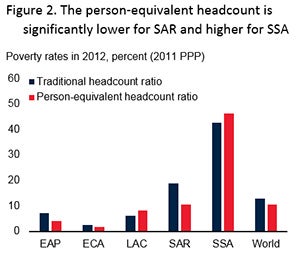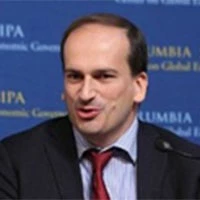As the latest
Global Monitoring Report (GMR) finds, the global poverty rate is expected to fall into the single digits for the first time in 2015 at 9.6 percent. While this is good news, when we look ahead, three major challenges stand out for development: the depth of remaining poverty, the unevenness in shared prosperity, and the persistent disparities in the non-income dimensions of development.
 First challenge: while the decline in poverty rates has been impressive, poverty remains unacceptably high and deep, especially in Sub-Saharan Africa. There remain 900 million extremely poor people in 2012, the last year for which surveys are available, and a projected 700 million people in 2015. Over the last decades, the vast majority (about 95 percent) of global poverty has been concentrated in three regions: East Asia and the Pacific, South Asia, and Sub-Saharan Africa (Figure 1). Yet, there have been large declines in poverty across Asia while Sub-Saharan Africa saw a steady increase and is now home to most of the global poor (43 percent).
First challenge: while the decline in poverty rates has been impressive, poverty remains unacceptably high and deep, especially in Sub-Saharan Africa. There remain 900 million extremely poor people in 2012, the last year for which surveys are available, and a projected 700 million people in 2015. Over the last decades, the vast majority (about 95 percent) of global poverty has been concentrated in three regions: East Asia and the Pacific, South Asia, and Sub-Saharan Africa (Figure 1). Yet, there have been large declines in poverty across Asia while Sub-Saharan Africa saw a steady increase and is now home to most of the global poor (43 percent).
To successfully tackle the remaining poverty, the policy discourse needs to focus on the poorest of the poor, especially in Sub-Saharan Africa, where poverty is most persistent. Poverty headcount rates—the share of the number of people living under $1.90 a day in the total population—provide a big-picture view of the spatial distribution of poverty and the pace of progress over time, but it does not inform us about critical differences among the extremely poor with respect to the depth of poverty—the extent to which the income of the extremely poor fall below the poverty line. Two countries could record the same poverty headcount rate, where in one country poverty is shallow and in the other it is very deep.
 To make “depth” a more central element of policy formulation, easy-to-communicate measures are needed. To this effect, the GMR introduces a new concept of “person-equivalent poverty,” which marries the intuitive appeal of a poverty headcount rate with the concept of depth. If the typical extremely poor person in a given base year falls 40 cents below the poverty line, then a person whose shortfall is 80 cents is considered and counted as two person-equivalents. Conversely, someone with a 20 cents shortfall would be a half person-equivalent. Counting all the person-equivalents and expressing them as a share in the population yields the person-equivalent poverty headcount rate. Using such a method provides the insight that, in person-equivalent terms, the poverty rate in Sub-Saharan Africa for 2012 rises from 43 to 46 percent, whereas that for South Asia falls from 19 to 10 percent thus placing emphasis on where poverty is deepest (Figure 2).
To make “depth” a more central element of policy formulation, easy-to-communicate measures are needed. To this effect, the GMR introduces a new concept of “person-equivalent poverty,” which marries the intuitive appeal of a poverty headcount rate with the concept of depth. If the typical extremely poor person in a given base year falls 40 cents below the poverty line, then a person whose shortfall is 80 cents is considered and counted as two person-equivalents. Conversely, someone with a 20 cents shortfall would be a half person-equivalent. Counting all the person-equivalents and expressing them as a share in the population yields the person-equivalent poverty headcount rate. Using such a method provides the insight that, in person-equivalent terms, the poverty rate in Sub-Saharan Africa for 2012 rises from 43 to 46 percent, whereas that for South Asia falls from 19 to 10 percent thus placing emphasis on where poverty is deepest (Figure 2).
Second challenge: there has been a stark unevenness in shared prosperity. Boosting shared prosperity is taken to promote the income growth of the bottom 40 (B40) percent of the income distribution of each country. Alongside the eradication of extreme poverty, the pursuit of shared prosperity comprises a key institutional objective for the World Bank Group. The characteristics of the B40 may differ significantly across countries. In some, all of the B40 are extremely poor, whereas in many other, richer countries the B40 include the moderately poor and those vulnerable to falling back in poverty. However poverty is measured—be it in absolute or relative terms, with reference to national or international poverty lines—the B40 focus squarely zooms in on the poorer segments of societies.
 Assessing the world’s performance on shared prosperity is made difficult by the sporadic and delayed availability of household survey data. Yet, based on the information available for circa 2007-12, most countries have registered relatively healthy income growth for their B40 populations. Yet, important differences exist. For example, half of the high-income countries and over a third of low-income countries saw B40 incomes decline in absolute terms (Figure 3). Moreover, relative to the earlier period of circa 2006-11, average B40 income growth slowed from 4.6 to 2.9 percent, whereas average income growth for the entire population declined from 3.0 to 1.7 percent.
Assessing the world’s performance on shared prosperity is made difficult by the sporadic and delayed availability of household survey data. Yet, based on the information available for circa 2007-12, most countries have registered relatively healthy income growth for their B40 populations. Yet, important differences exist. For example, half of the high-income countries and over a third of low-income countries saw B40 incomes decline in absolute terms (Figure 3). Moreover, relative to the earlier period of circa 2006-11, average B40 income growth slowed from 4.6 to 2.9 percent, whereas average income growth for the entire population declined from 3.0 to 1.7 percent.
Third challenge: there are persistent disparities in the “non-income” dimensions of development between the poor and the non-poor and between the B40 and the rest of the population (Figure 4). The absolute deprivations and inequalities of opportunity of the poor and the B40 in these non-income dimensions tend to transmit poverty across generations and erode the pace and sustainability of shared prosperity.
 Poverty and prosperity are both multidimensional concepts. Central aspects of both are income deprivations that restrict an individual’s ability to consume certain basic goods, such as lack of access to education, health, housing, employment, personal security, and more. Clearly, as the GMR shows, the world has made significant progress in many of these non-income dimensions over the period of the expiring Millennium Development Goals. But significant work remains. Close to one-fifth of all children under five remain undernourished, and some 860 million people continue to live in slums. Access to primary school education and literacy rates have improved, yet the quality of education remains a concern. Moreover, while the tide has turned on the incidence of major deadly diseases, a high number of preventable deaths persist.
Poverty and prosperity are both multidimensional concepts. Central aspects of both are income deprivations that restrict an individual’s ability to consume certain basic goods, such as lack of access to education, health, housing, employment, personal security, and more. Clearly, as the GMR shows, the world has made significant progress in many of these non-income dimensions over the period of the expiring Millennium Development Goals. But significant work remains. Close to one-fifth of all children under five remain undernourished, and some 860 million people continue to live in slums. Access to primary school education and literacy rates have improved, yet the quality of education remains a concern. Moreover, while the tide has turned on the incidence of major deadly diseases, a high number of preventable deaths persist.
For the world to register sustained development progress over the Sustainable Development Goal (SDG) period, it is essential that these three interrelated challenges are tackled collectively. The SDG framework augurs for a more holistic approach to development. Whether the world can galvanize its efforts towards scaled-up development impact will, however, require a much greater focus on the depth of remaining poverty, the unevenness of shared prosperity, and the persistent non-income dimensions of development.
 First challenge: while the decline in poverty rates has been impressive, poverty remains unacceptably high and deep, especially in Sub-Saharan Africa. There remain 900 million extremely poor people in 2012, the last year for which surveys are available, and a projected 700 million people in 2015. Over the last decades, the vast majority (about 95 percent) of global poverty has been concentrated in three regions: East Asia and the Pacific, South Asia, and Sub-Saharan Africa (Figure 1). Yet, there have been large declines in poverty across Asia while Sub-Saharan Africa saw a steady increase and is now home to most of the global poor (43 percent).
First challenge: while the decline in poverty rates has been impressive, poverty remains unacceptably high and deep, especially in Sub-Saharan Africa. There remain 900 million extremely poor people in 2012, the last year for which surveys are available, and a projected 700 million people in 2015. Over the last decades, the vast majority (about 95 percent) of global poverty has been concentrated in three regions: East Asia and the Pacific, South Asia, and Sub-Saharan Africa (Figure 1). Yet, there have been large declines in poverty across Asia while Sub-Saharan Africa saw a steady increase and is now home to most of the global poor (43 percent).
To successfully tackle the remaining poverty, the policy discourse needs to focus on the poorest of the poor, especially in Sub-Saharan Africa, where poverty is most persistent. Poverty headcount rates—the share of the number of people living under $1.90 a day in the total population—provide a big-picture view of the spatial distribution of poverty and the pace of progress over time, but it does not inform us about critical differences among the extremely poor with respect to the depth of poverty—the extent to which the income of the extremely poor fall below the poverty line. Two countries could record the same poverty headcount rate, where in one country poverty is shallow and in the other it is very deep.
 To make “depth” a more central element of policy formulation, easy-to-communicate measures are needed. To this effect, the GMR introduces a new concept of “person-equivalent poverty,” which marries the intuitive appeal of a poverty headcount rate with the concept of depth. If the typical extremely poor person in a given base year falls 40 cents below the poverty line, then a person whose shortfall is 80 cents is considered and counted as two person-equivalents. Conversely, someone with a 20 cents shortfall would be a half person-equivalent. Counting all the person-equivalents and expressing them as a share in the population yields the person-equivalent poverty headcount rate. Using such a method provides the insight that, in person-equivalent terms, the poverty rate in Sub-Saharan Africa for 2012 rises from 43 to 46 percent, whereas that for South Asia falls from 19 to 10 percent thus placing emphasis on where poverty is deepest (Figure 2).
To make “depth” a more central element of policy formulation, easy-to-communicate measures are needed. To this effect, the GMR introduces a new concept of “person-equivalent poverty,” which marries the intuitive appeal of a poverty headcount rate with the concept of depth. If the typical extremely poor person in a given base year falls 40 cents below the poverty line, then a person whose shortfall is 80 cents is considered and counted as two person-equivalents. Conversely, someone with a 20 cents shortfall would be a half person-equivalent. Counting all the person-equivalents and expressing them as a share in the population yields the person-equivalent poverty headcount rate. Using such a method provides the insight that, in person-equivalent terms, the poverty rate in Sub-Saharan Africa for 2012 rises from 43 to 46 percent, whereas that for South Asia falls from 19 to 10 percent thus placing emphasis on where poverty is deepest (Figure 2).
Second challenge: there has been a stark unevenness in shared prosperity. Boosting shared prosperity is taken to promote the income growth of the bottom 40 (B40) percent of the income distribution of each country. Alongside the eradication of extreme poverty, the pursuit of shared prosperity comprises a key institutional objective for the World Bank Group. The characteristics of the B40 may differ significantly across countries. In some, all of the B40 are extremely poor, whereas in many other, richer countries the B40 include the moderately poor and those vulnerable to falling back in poverty. However poverty is measured—be it in absolute or relative terms, with reference to national or international poverty lines—the B40 focus squarely zooms in on the poorer segments of societies.
 Assessing the world’s performance on shared prosperity is made difficult by the sporadic and delayed availability of household survey data. Yet, based on the information available for circa 2007-12, most countries have registered relatively healthy income growth for their B40 populations. Yet, important differences exist. For example, half of the high-income countries and over a third of low-income countries saw B40 incomes decline in absolute terms (Figure 3). Moreover, relative to the earlier period of circa 2006-11, average B40 income growth slowed from 4.6 to 2.9 percent, whereas average income growth for the entire population declined from 3.0 to 1.7 percent.
Assessing the world’s performance on shared prosperity is made difficult by the sporadic and delayed availability of household survey data. Yet, based on the information available for circa 2007-12, most countries have registered relatively healthy income growth for their B40 populations. Yet, important differences exist. For example, half of the high-income countries and over a third of low-income countries saw B40 incomes decline in absolute terms (Figure 3). Moreover, relative to the earlier period of circa 2006-11, average B40 income growth slowed from 4.6 to 2.9 percent, whereas average income growth for the entire population declined from 3.0 to 1.7 percent.
Third challenge: there are persistent disparities in the “non-income” dimensions of development between the poor and the non-poor and between the B40 and the rest of the population (Figure 4). The absolute deprivations and inequalities of opportunity of the poor and the B40 in these non-income dimensions tend to transmit poverty across generations and erode the pace and sustainability of shared prosperity.
 Poverty and prosperity are both multidimensional concepts. Central aspects of both are income deprivations that restrict an individual’s ability to consume certain basic goods, such as lack of access to education, health, housing, employment, personal security, and more. Clearly, as the GMR shows, the world has made significant progress in many of these non-income dimensions over the period of the expiring Millennium Development Goals. But significant work remains. Close to one-fifth of all children under five remain undernourished, and some 860 million people continue to live in slums. Access to primary school education and literacy rates have improved, yet the quality of education remains a concern. Moreover, while the tide has turned on the incidence of major deadly diseases, a high number of preventable deaths persist.
Poverty and prosperity are both multidimensional concepts. Central aspects of both are income deprivations that restrict an individual’s ability to consume certain basic goods, such as lack of access to education, health, housing, employment, personal security, and more. Clearly, as the GMR shows, the world has made significant progress in many of these non-income dimensions over the period of the expiring Millennium Development Goals. But significant work remains. Close to one-fifth of all children under five remain undernourished, and some 860 million people continue to live in slums. Access to primary school education and literacy rates have improved, yet the quality of education remains a concern. Moreover, while the tide has turned on the incidence of major deadly diseases, a high number of preventable deaths persist.
For the world to register sustained development progress over the Sustainable Development Goal (SDG) period, it is essential that these three interrelated challenges are tackled collectively. The SDG framework augurs for a more holistic approach to development. Whether the world can galvanize its efforts towards scaled-up development impact will, however, require a much greater focus on the depth of remaining poverty, the unevenness of shared prosperity, and the persistent non-income dimensions of development.




Join the Conversation